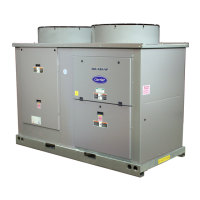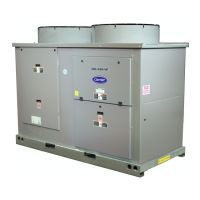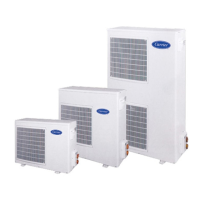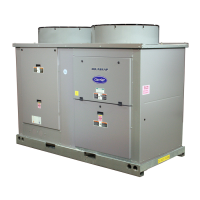30
The following tables summarise the possible selections
depending on the control types (local, remote or CCN)
and the following parameters:
• Setpoint select in local control: item #13 of the Infor-
mation menu permits selection of the active setpoint,
if the unit is in local operating type.
• Heating/cooling operating mode.
• Control contacts 2: status of control contact 2.
• Schedule 2 status: schedule for setpoint selection.
Depending on the current operations, the active setpoint
can be selected by choosing the item in the Information
menu, with the user’s volt-free contacts, with network
commands or with the setpoint timer program (schedule 2).
Cooling sp 1 Cooling setpoint 1
Cooling sp 2 Cooling setpoint 2
Cooling [2] Auto Activated Unoccupied Ice storage setpoint
Cooling [2] Auto Activated Open Unoccupied Cooling setpoint 2
Cooling Auto Closed Occupied Cooling setpoint 1
Cooling Auto Deactivated Unoccupied Cooling setpoint 2
Heating sp 1 Heating setpoint 1
Heating sp 2 Heating setpoint 2
Heating Auto Occupied Heating setpoint 1
Heating Auto Unoccupied Heating setpoint 2
Cooling [2] sp control Control setpoint
Cooling sp 1 (open) Cooling setpoint 1
Cooling sp 2 (closed) Cooling setpoint 2
Cooling [2] Activated Open Cooling setpoint 1
Cooling [2] Activated Open Closed Ice storage setpoint
Cooling [2] Activated Closed Closed Cooling setpoint 2
Heating sp 1 (open) Heating setpoint 1
Heating sp 2 (closed) Heating setpoint 2
Cooling Occupied Cooling setpoint 1
Cooling Unoccupied Cooling setpoint 2
Cooling [2] Activated Open Unoccupied Ice storage setpoint
Cooling [2] Activated Closed Unoccupied Cooling setpoint 2
Heating Occupied Heating setpoint 1
Heating Unoccupied Heating setpoint 2
[2] Only with energy management option.
5.6.2 - Reset
Reset means that the active setpoint is modified so that
less machine capacity is required (in cooling mode, the
setpoint is increased, in heating mode it is decreased). This
modification is in general a reaction to a drop in the load.
For the Pro-Dialog control system, the source of the reset
can be configured in the User 1 configuration: it can be
provided either by the outdoor temperature (that gives a
measure of the load trends for the building) or by the return
water temperature (delta T that gives an average building
load) either for the reset setpoint based on a 4-20 mA input
(with energy management option) or based on the room
temperature, using a room temperature sensor (when the
energy management option is used). In response to a drop
in the outdoor temperature or to a drop in delta T, the
cooling setpoint is normally reset upwards in order to
optimise unit performance:
In the three cases the reset parameters, i.e. slope, source
and maximum value, are configurable in the Setpoints
menu (see section 4.3.8). Reset is a linear function based
on three parameters.
A Maximum reset value
B OAT or delta T for no reset
Reset value
Outdoor temperature (OAT)
Evaporator Delta T
% Building load
• A reference at which reset is zero (outdoor
temperature or delta T - no reset value).
• A reference at which reset is maximum (outdoor
temperature or delta T - full reset value).
• The maximum reset value.
C OAT or delta T for full reset
D Building Load
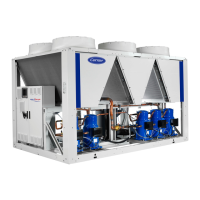
